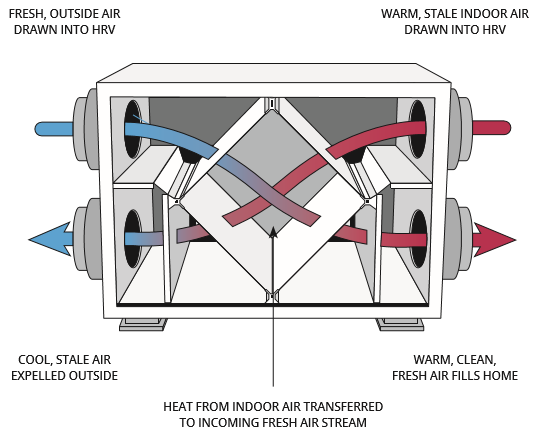How to Save Money with HRV in Variable Seasons
Checking out the Benefits of Heat Recovery Ventilation for Power Performance in Homes
Heat Recovery Ventilation (HRV) systems offer house owners a sensible strategy to improving energy performance. By reclaiming heat from outgoing air, these systems can significantly lower cooling and heating costs. In addition, they give a constant supply of fresh air, enhancing indoor air top quality and convenience degrees. As property owners consider lasting alternatives, recognizing the subtleties of HRV systems comes to be significantly crucial. What factors should one examine prior to making such an investment?
Recognizing Heat Recovery Ventilation Solutions

How HRV Enhances Indoor Air Quality

Power Financial Savings: The Financial Advantages of HRV
Optimizing energy efficiency, heat recovery ventilation (HRV) systems supply substantial monetary benefits for property owners. By recouping and recycling warm from exhaust air, HRVs markedly lower heating & cooling expenses. This modern technology can result in energy savings of up to 30%, relying on environment and use patterns. Home owners frequently observe decreased utility expenses soon after setup, making HRVs an economically smart financial investment over time. Additionally, lots of areas provide incentives or rebates for energy-efficient upgrades, even more improving the financial appeal. As energy costs remain to climb, the cost-effectiveness of HRVs becomes increasingly clear. Overall, the incorporation of HRV systems not only advertises energy effectiveness but likewise adds to long-term monetary savings for houses.
The Environmental Effect of Heat Recovery Ventilation
A substantial ecological advantage of heat recovery ventilation (HRV) systems hinges on their capacity to minimize total energy usage. By redeeming warmth from exhaust air and transferring it to inbound fresh air, HRV systems lessen the need for energy-intensive heating and cooling down techniques. This reduction in energy demand adds to about his lower greenhouse gas exhausts, as less nonrenewable fuel source is required to maintain comfy indoor temperature levels. In addition, HRV systems improve indoor air high quality by efficiently trading stagnant air with fresh outdoor air, reducing reliance on mechanical cooling systems that can harm the setting. Generally, the execution of HRV anchor systems sustains lasting living techniques and lines up with global efforts to fight environment modification by advertising energy effectiveness in property settings.
Selecting the Right HRV System for Your Home
Exactly how can property owners ensure they choose the ideal heat recovery ventilation (HRV) system for their demands? Initially, they ought to examine their home's size and layout, as these elements influence airflow requirements. Next off, examining the system's effectiveness scores is important, as greater rankings show far better performance and energy savings. Home owners must also think about installment and upkeep prices, contrasting various brand names and designs for value. Furthermore, it is very important to review noise levels, as some systems operate more silently than others. Consulting with a/c specialists can offer customized recommendations based upon certain home conditions. Finally, checking out individual testimonials and service warranties can aid in making a notified decision, ensuring that the chosen HRV system effectively improves interior air quality and power efficiency.
Frequently Asked Concerns

How Often Should I Clean or Maintain My HRV System?
The frequency of cleansing or preserving a warmth recovery ventilation (HRV) system usually relies on use and environmental aspects. Usually, it is recommended to perform maintenance every six months to assure peak efficiency and air high quality.

Can HRV Solutions Help In Reducing Moisture Levels Indoors?
HRV systems Learn More can successfully reduce interior moisture levels by exchanging stagnant, moist air with fresh, drier air from outside. HRV Heat Recovery Ventilation. This procedure helps keep a well balanced indoor environment, boosting comfort and avoiding moisture-related issues
What Is the Lifespan of a Regular HRV System?
The life-span of a normal heat recovery ventilation (HRV) system differs, generally lasting in between 10 to 15 years. Regular upkeep can expand its performance and operational life, making sure peak performance throughout its use period.
Are There Any Noise Worries With HRV Equipments?
Noise worry about HRV systems can arise, especially from fan operation. Several modern-day systems are developed to lessen audio degrees, ensuring they run silently while maintaining performance, which resolves possible disruptions in living atmospheres.
Can I Mount an HRV System Myself, or Do I Required a Specialist?
The private contemplated whether to mount the heat recovery ventilation (HRV) system directly or hire a professional. Usually, while DIY installment is possible, expertise guarantees appropriate functionality and compliance with regional building regulations, enhancing system performance.